Ultimate Guide to Fountain Lights
Table of Contents
The presence of a fountain in your landscape is indeed splendid, yet when illuminated adequately, it turns simply breathtaking. It presents onlookers with an enthralling and unforgettable encounter, making the location stand out. However, it demands careful consideration and strategic planning to highlight a fountain within a landscape setting effectively.
This piece will provide comprehensive insights into everything you need to understand about fountain lights and the best implementation approaches. So, without further ado, let’s dive right in.
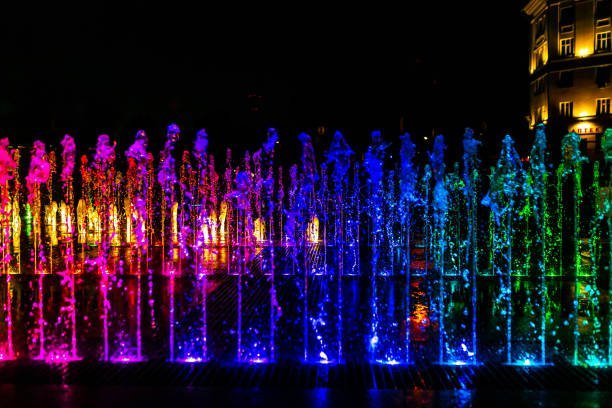
Understanding Fountain Lights
In basic terms, fountain lights light up water fountains within landscapes, enhancing their beauty. Fountains usually serve as the primary focus of a landscape. Therefore, it’s crucial to provide sufficient lighting to animate the area. Most fountain lights are underwater, but some designs can also be used externally.
Because these lights operate in a watery environment, they must fulfill certain specifications for optimal operation. They must be waterproof, resilient, and able to endure varying temperatures. Installing light fixtures that lack these attributes could cause a multitude of issues.
Considerations for Fountain Lights Design
Designing fountain lights involves considering several factors:

Fountain Dimensions and Form
The size and shape of the fountain will influence the number and positioning of lights needed for the desired illumination effect. Larger or multi-tiered fountains may require multiple light sources at varying angles for balanced coverage.
Power Supply
The available power source at the fountain location will guide the choice and size of lights that can be utilized. It’s important to ensure the voltage and current capacity match the lighting system to avoid overloads or inefficiency.
Lighting Type and Color
Choosing between warm white, cool white, or color-changing (RGB) lights depends on the intended ambiance. LED lights are commonly preferred due to their energy efficiency, long life, and availability in various colors and effects.
Water Resistance and Durability
Fountain lights must be fully waterproof—typically IP68-rated—to function safely underwater. They should also be built with corrosion-resistant materials like stainless steel or marine-grade plastic to withstand constant exposure to water and chemicals.
Beam Angle and Light Distribution
The beam angle determines how wide or narrow the light spreads. Narrow beams are ideal for highlighting specific features like statues or cascades, while wider beams create general illumination. Strategic placement ensures even and aesthetic lighting.
Control System and Automation
Modern fountain lights often come with control systems that allow for automated lighting sequences, remote control, and even music synchronization. Using DMX or smart controllers adds flexibility and enhances the visual experience.
Safety and Installation
Safety is a top priority when dealing with electrical components near water. Low-voltage lighting systems are commonly used to minimize risk. Proper sealing, grounding, and professional installation ensure the setup is safe, reliable, and long-lasting.
Types of Light
There are three primary options for lighting your fountain: incandescent bulbs, halogen bulbs, and LEDs. While the first two are cheap, they’re not the best choices for fountain lights due to their high power consumption and relatively short lifespan. Despite their higher initial cost, LEDs are more resilient, cost-effective, and energy-efficient, leading to substantial energy savings. LEDs also offer flexibility in design.
Environmental Conditions
Factors such as wind, water spray, and humidity levels will affect the lifespan and performance of the light fixtures.
Light Control System
As fountain lights enhance landscape aesthetics, you may want to modify them periodically to maintain freshness. Both traditional (incandescent and halogen) and modern (LED) lights have control systems. However, LEDs provide more control options, such as color, temperature, and frequency adjustment, easily controlled via a smartphone or remote.
Fountain Lights Color
Adding colors to fountain lights enhances their aesthetic appeal and artistic quality. LED technology provides a range of color temperatures to influence visitor moods. Examples include white lights for a clean look, blue for a calming effect and focus, and orange for a bold, energetic display.
Maintenance Needs
Consider the maintenance needs of the lighting fixtures for long-term performance and reliability.
Budget
The budget for the project will affect the choice of lighting fixtures, as well as the required number and positioning of lights for the desired lighting effect.
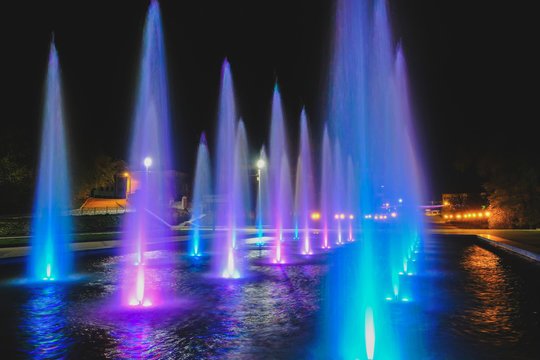
Categories of Fountain Lights
The necessity for fountain lights to be submergible reduces the available fixture options. However, advances in technology have led to a reasonable range of choices. The well-liked choices encompass:
Spotlights
These cast a focused beam of light to draw attention to the fountain. You can transform the water feature into an artful display by deploying multiple small spotlights around the fountain.
Pool Lights
Designed to stay underwater for extended periods, these lights are usually installed in swimming pools but can also be fitted on the fountain walls and floor.
Recessed Lights
These lights are mounted within the surface, leaving only the front part visible while the remainder is concealed. Recessed lights can be utilized on fountain walls for lighting.
IP68 LED Neon Lights
These lights offer excellent waterproofing and corrosion resistance, making them ideal for underwater use. They provide uniform linear illumination without visible hotspots, making them perfect for creating smooth, seamless lighting effects in water features and pools without compromising light quality.
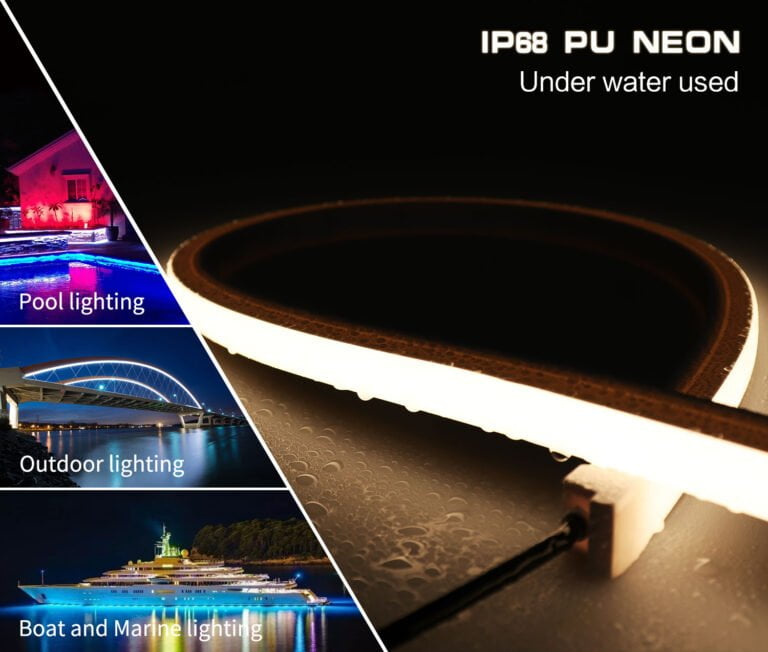
Guidelines for Effectively Lighting Fountains
With the basic principles of fountain lighting under your belt, let’s delve into the methods to implement this lighting appropriately.
Meticulous Planning
In illuminating fountains, an in-depth plan is critical, as it requires an understanding of the individual features of light. For instance, various hues of light can evoke different emotions. Therefore, you can choose the right color once you’re clear about the ambiance you wish to cultivate around your fountain. For instance, establishing a tranquil environment with orange lights might not work well.
Choosing the Desired Effects
Assuming you’re utilizing LEDs as your fountain lights, you’re offered three options previously discussed. Each type of fixture engenders a unique effect. For example, spotlights generate an intense, focused beam of light, whereas pool lights produce a softer glow. Your choice of effect should be contingent on the desired aesthetic of your fountain.
Selecting the Ideal Color
Color holds a substantial influence over a location’s ambiance. You should choose a color that aligns with the mood you intend to foster around your fountain. For example, orange lights could be an intriguing choice if your landscape often serves as a party venue. However, blue or white lights may be more fitting if your landscape is primarily a tranquil retreat.
While smart LEDs allow for color flexibility, they do come with a higher price tag, making them inaccessible for some.
Positioning of Lights
The final step requires a clear understanding of the fountain’s dimensions to position the lights appropriately. It’s crucial to choose fixtures that complement the size and shape of the fountain. Subtle lighting enhances the fountain’s aesthetic appeal, while overly conspicuous lighting may be jarring. Moreover, wiring must be carefully managed to remain inconspicuous and safe for those frequenting the area around the fountain.
Installation and Maintenance of Fountain Lights
Installing and maintaining fountain lights don’t differ significantly from handling landscape lights. Underground wiring is preferable, and occasional checks on fixture components ensure smooth operation. However, there are specific considerations when installing fountain lights, such as:
Depth
The water’s depth dictates the suitable type of fixtures for your fountain. Deep water diffuses the light beam and reduces its impact. Hence, using underwater lights for a fountain with a depth exceeding 4 feet is impractical. Instead, consider fixtures designed for use around the fountain’s walls. For shallow waters, underwater lights are ideal.
Clarity
Water clarity also affects fixture choice and subsequent maintenance. The water should be clear for the desired effects if underwater lights are used. If the fountain tends to accumulate debris, it’s advisable to use side-mounted lights.
Movement
In setting up fountain lights, ensure the light beam doesn’t overpower the water’s flow. Simply put, the light shouldn’t cut through the water.
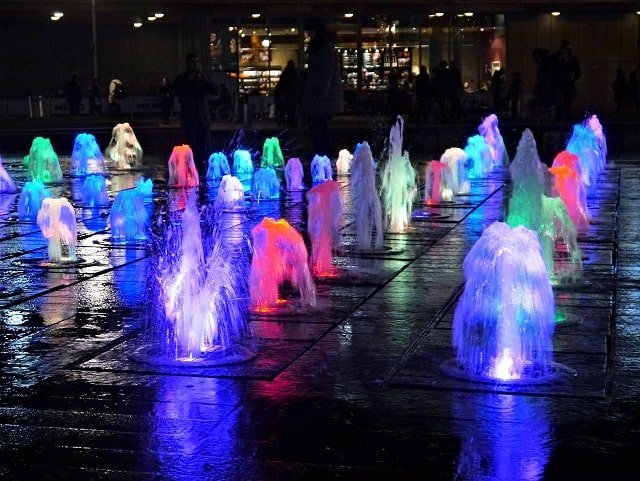
Lighting Fountains in Public Spaces
Lighting public fountains can draw more visitors, such as the fountain spectacle at Dubai’s Burj Khalifa. While recreating this scale might not be feasible, it provides a glimpse of the potential benefits. Lighting fountains in public areas can enhance property value and attract more visitors, which is particularly advantageous for commercial spaces.
Lighting Fountains for Personal Use
Similarly, lighting fountains in private spaces can increase property value and leave lasting impressions on visitors. It serves as a unique backdrop for parties and a peaceful nighttime retreat after a busy day.
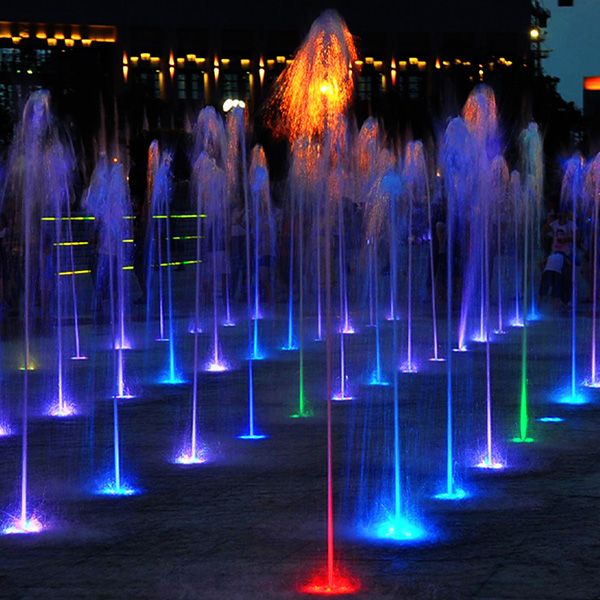
In Conclusion
Fountain power to transform a landscape, infusing it with vitality dramatically. Beyond the aesthetic appeal, these lights contribute to property value and security. To reap these benefits, it’s crucial to consider various factors, hopefully, clarified in this article.
At MyLikeLed, We manufacture top-tier LED strips and LED neon flex, with all our products undergoing rigorous quality checks in high-tech labs. We also offer customizable LED strips and neon flex. Contact MyLikeLed today for superior LED strip and LED neon flex solutions!
FAQs
What type of lights are best for fountains?
LED lights are best for fountains because they are energy-efficient, long-lasting, waterproof, and available in various colors and lighting effects.
Are fountain lights waterproof?
Yes, fountain lights are designed to be fully waterproof with IP68-rated fixtures that can operate safely when submerged in water.
Can I change the colors of fountain lights?
Yes, many LED fountain lights come with RGB or RGBW options, allowing you to change colors and effects using a remote or controller.
How do I install fountain lights?
Fountain lights can be installed underwater, on the fountain base, or around the perimeter. Ensure proper sealing and use a low-voltage power supply for safety.
Do fountain lights require maintenance?
Yes, regular maintenance involves cleaning the lenses, checking waterproof seals, and ensuring power connections remain secure and corrosion-free.
Can fountain lights run all night?
Yes, high-quality LED fountain lights are designed for long operation hours and can safely run all night, especially when paired with timers or smart controls.

Hi, I’m Xylia Xiong, a sales professional with 14 years of experience in the LED strip light industry. I specialize in providing tailored solutions, leveraging my expertise in LED products and the latest industry trends. Known for effective communication and problem-solving, I’m dedicated to helping lighting manufacturers, importers, and distributors achieve their goals.
Let’s work together to create customized solutions that exceed expectations.
Related Posts

The Best LED Strip Lights You Can Buy Right Now

Comparing WS2811 Vs WS2812B: Key Differences


